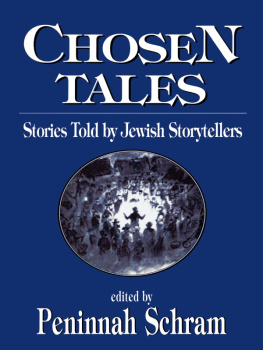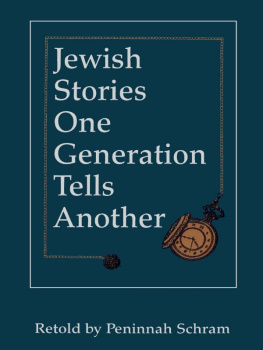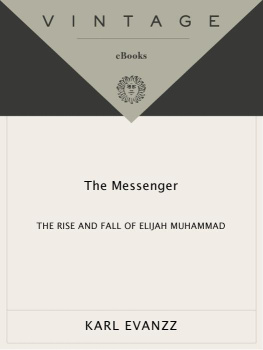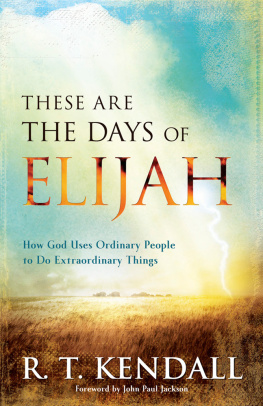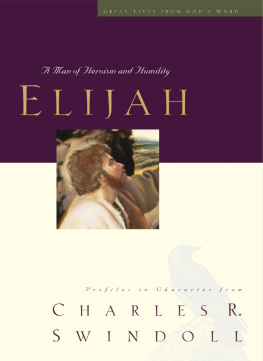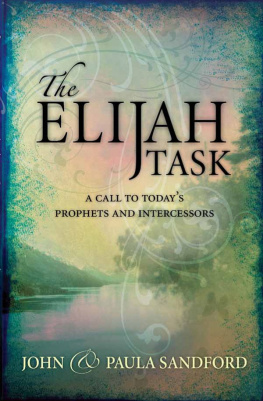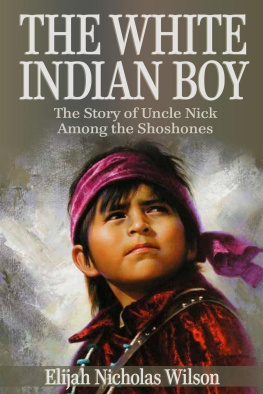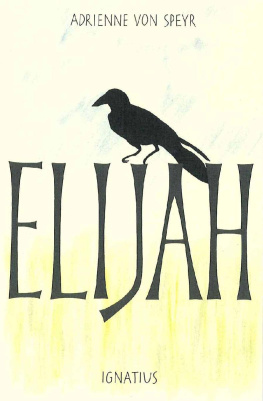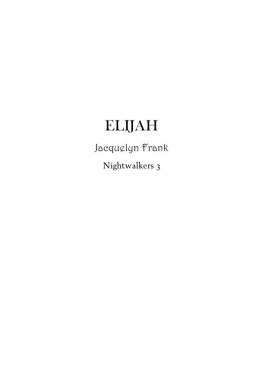Tales of Elijah
the Prophet

Tales of Elijah
the Prophet
Retold by
Peninnah Schram
Foreword by Dov Noy

First Jason Aronson Inc. softcover edition1997
Permission to use the drawing of Elijah by Zuni Maud has been granted by Ben Kaplan.
Copyright 1991 by Peninnah Schram
10 9 8 7 6 5 4 3 2 1
All rights reserved. Printed in the United States of America. No part of this book may be used or reproduced in any manner whatsoever without written permission from Jason Aronson Inc. except in the case of brief quotations in reviews for inclusion in a magazine, newspaper, or broadcast.
Library of Congress Cataloging-in-Publication Data
Schram, Peninnah.
Tales of Elijah the Prophet / retold by Peninnah Schram.
p. cm.
Includes bibliographical references (p. ) and index.
ISBN: 978-0-7657-5991-7
1. Elijah (Biblical prophet)Legends. 2. Legends, Jewish.
3. Jewish folk literature. I. Title.
BS580.E4S36 1991
296.6'dc20
90-24914
Manufactured in the United States of America. Jason Aronson Inc. offers books and cassettes. For information and catalog write to Jason Aronson Inc., 230 Livingston Street, Northvale, New Jersey 07647.
To the six people in my life
who opened successive doors to teach and to tell
to record and to write
in them are sparks of Elijah
Alan J. Schwartz
Abraham Tauber 
David Mirsky 
Nathan Kolodney
Richard Borgersen
Arthur Kurzweil
Contents
by Dov Noy
When Will the Messiah Come? Elijah and the Three Wishes
Foreword
Peninnah Schrams newest book, Tales of Elijah the Prophet, concentrates on a single hero, unlike her previous collection (Jewish Stories One Generation Tells Another, 1987), whose subject matter was universal. However, because of the specific and unique role played by Elijah in the folk tradition of every Jewish ethnic group, and because the main source of selected folktalesthe Israel Folktale Archives (IFA) at Haifa Universityuniversally acclaimed as the worlds storehouse of Jewish narrative lore, the present sample is characteristic of Jewish folklore in the past and present.
The legends selected, each because of its literary and ethical values, as well as the editors Introduction and her annotations,. are indeed praiseworthy. Peninnah Schram poses the most important question in the Jewish folklore connected with the acting character of Elijah the Prophet. This puzzle, as the problem is called (and rightly so) in the Introduction is: Why is Elijah so revered a character in every age and in every land where Jews have lived? This question can be expanded to: Why has Elijah become a favorite hero who overshadows other biblical and postbiblical heroes in the Jewish folk-tradition, heroes who undoubtedly play a more important role in Jewish thought and tradition (such as Abraham our Father, Moses our Teacher, King David, and others, among them many folklore protagonists like King Solomon, Maimonides, and chasidic rabbis)?
The conventional answers to the above questions, suggested also in the Introduction, connect Elijah, the living folk hero, with his biblical predecessor, the Israelite prophet of the ninth century B.C.E. Although there is no doubt that many of the narrative motifs in the Elijah stories in 1 Kings and in our collection are identical or similar, the main features of Elijah among us, in our time and space, in disguise, appearing unexpectedly and solving problems, rescuing Jewish individuals and communities in danger, punishing and rewarding human deeds, stressing social justice, all these and many other features, cannot be explained by biblical parallels or roots.
The same holds true with customs prevailing in the life-cycle and yearly cycle of almost every Jewish ethnic group, during the circumcision ceremony, the end of Shabbat, the Seder night, and on many other occasions. A clear biblical connection is hardly possible. Let us take, for example, the circumcision chair. Why is it an Elijah chair and not an Abraham chair? Was not Abraham the first man circumcised in the Torah? Was he not the first circumciser? Elijah the Prophet can, of course, be connected with some logic to the rite of circumcision, but is this connection stronger than that of Abraham our Patriarch?
Many Elijah narratives go back to Jewish customs whose origins in the realm of folk-belief are obscure; the biblical connections, often proposed by the participants in the rite, the performers of the custom, and the narrators and their audiences, have no scientific basis. Until this very day, the practical kabbalists solve problems, both halakhic and real, by seeking an Elijah Revelation (giluy Eliyahu), mostly in a dream, following forty days of taboos, compulsions, or magic practices. Visiting holy sites bearing the name of Elijah and telling stories there (in addition to prayer) are part of that tradition. Can the Elijah caves and synagogues in Alexandria, Damascus, and many other places be connected to a biblical context, as often claimed by the narrators in their etiological legends? These Elijah sites play an important role in Jewish folk-religion and in Jewish folk-medicine. Many of the IFA Elijah folktales were collected in the Mount Carmel Elijah cave, revered and used by Jews, Moslems, Christians, and Druze of Haifa and northern Israel.
Not one Elijah tale of the approximately 600 Elijah stories at the IFA is set in biblical time and space. Not one of them is an expanded biblical legend with King Ahab or Queen Jezebel, Elijahs contemporaries, as its protagonist, expanding on the confrontation with the priests of Baal on Mount Carmel or the incidents with the woman at Zarephat, or the ravens feeding beside the Charith brook. Nor do we have among the living stories narratives about Elijah as the herald of the future redemption or as the precursor of the Messiah, motifs so well known from rabbinic literature and written sources.
There is, however, an inherent structural connection between Elijah the Prophet legends and those relating to the thirty-six Hidden Saints (Lamedvovniks) who imitate the deeds of their prototype, although not explicitly. The Hidden Saints tradition is another late Judaic folk-traditionalthough the roots and the formulistic number are old, the intensity of the Lamedvov legends is lateand the thirty-six Elijah samples selected by Peninnah Schram may be connected to the Hidden (and therefore unexpected and unpromising) Hero motif.
Some scholars, who admit that the present mainstream of Elijah traditions does not originate in the Bible, claim an early postbiblical origin and a connection with Enoch in order to explain it. There is, indeed, a structural similarity between Enoch and Elijah, and it is mentioned by the sixteenth-century Safed kabbalist Rabbi Moses Cordovero. Their main similarity is that they were the only two biblical heroes to be carried from earthly life in an extraordinary way. They can therefore be regarded as human symbols of immortality. In the early postbiblical, pseudoepigraphical literature, the only outstanding protagonist is, however, Enoch. And no wonder. His advantages over Elijah are many: his is the seventh, and therefore the holiest, generation of the human race; his span of life in years corresponds to the number of days in the solar year; his extraordinary termination of life on earth is clearly connected, twice, with God, with whom he walked and who took him. None of these three merits is mentioned in the case of Elijah.
Next page

